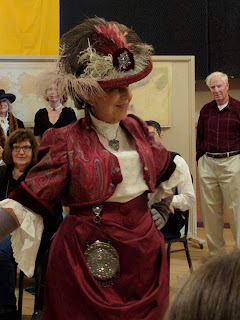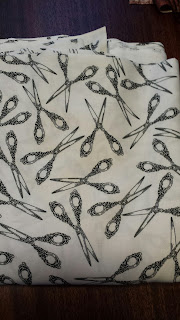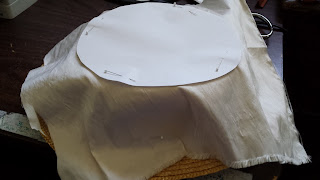I’ve been waiting in hopes of someone coming up with photos
from the fashion show I wrote and presented on April 1 at the Port Townsend
Victorian Heritage Festival in Washington state. http://2017.vicfest.org/
Other than a couple one nice lady texted to me
that day, we haven’t received any. So instead of waiting any longer, I’m
writing this blog post with what I have and at a later date if we do get any, I
can do an addendum post.
This was my sixth year of being in the fashion show there
but my first year of writing the narrative and presentation. It was exciting to
me to be asked to do this and fortunately I had a great pool of models and
dresses from the Seattle-based guilds, SITU (Someplace in Time, Unlimited), and
the Puget Sound Costume Guild. I contacted some of the previous models from
past years and had a couple responses from there.
For my first time, I picked my easiest theme, a timeline of
dress. I was able to use one of my ideas I’d had in the past there of having
the narrative include local names of places in town, and relating to the
history of Port Townsend so it would make it a special theme just for them. The
title was “Victorians Dress for the Occasion”. It included the timeline of the
city at its bustling time of 1850 to 1900.
Next, I wanted to change up the way it was done in the past,
and when we found out our new location would be inside the American Legion Hall
where the majority of the main events are held, like the Victorian ball, it was perfect. It’s a
good size room, has lovely wooden floors with a stage at one end, and a pop-up
stage at the opposite end for musicians. Instead of being up on the stage, I
asked that we do it on the main floor with chairs set up around the center
where we could walk down it. It gave us a longer area to walk and we could go
back and forth to give everyone time to see us, and get a closer view. Later I
heard very good reviews of the set-up. And a grateful shout-out goes to the
volunteer workers who did such a wonderful job of setting up the chairs and our
enclosed dressing area.
After gathering up a group of 12 models and their dress
descriptions, I set about the time consuming task of writing them into a story for each of them. Each one had to be a specific length so that we all fit into
the one hour show we were doing. Some were a little longer that had to be
edited down, while others had to have more details added but with the help of my “Model’s Questionnaire” it gave me plenty to fill in with.
On the day all of us arrived for the show, the room was
already set up for us, with large room barriers placed along the far wall as
our dressing area, with a row of tables and chairs for us. Each end was open
for us to enter or exit. At the far left end there was an exit door leading out
to a ramp with a parking lot below it. It’s not a public parking lot but I
think we could use it for loading in and loading out for the show, rather than
carrying everything down the street from the hotel like we did. Yes, we
stretched our arms about 3 feet longer by the time we got there. When you’re
bringing in snacks and water, and costumes, it gets pretty heavy.
I took some photos backstage, as I always do, because I knew
we might not get any later. This year I didn’t have any friends in the
audience, and even though my Mom was there, my cell phone isn’t the easiest
thing for someone to take photos with if you’re not used to it, and the battery
was dying most of the time I was there. Port Townsend is not very conducive to
internet and cell phone signals. These were a couple I took before it did die.
Marc, our Canadian Mountie, was hilarious. He walked in when
some of us (me) were partially undressed (corsets showing OMG!) and he blushed
and threw his hat up in front of his face and walked through us not wanting to
see anything. We’ll have to cure him of that if he wants to continue joining
us. LOL! Next year we do plan on a separate completely closed off dressing area
(maybe up on the unused stage?) for those that need to totally change clothes,
as this wasn’t a completely private area.
Our narrator, Beverly, a local store owner in Port Townsend, was up on the pop-up stage with her
daughter. After
I did a quick walk-through of the layout, I decided we would walk out of the
far end by the stage and come out into the center of the room, walk to the
back, reverse to the other end, then come back to the center where we could
exit back into the other end of the dressing area. Because of the space being
so open we were able to walk farther during our 1 minute descriptions instead
of a very short stage, and it gave people much longer to look at us and take
photos. Oh, to have all those photos!
At the end of the show, we all walked back out and lined up
for a final group view. I had written a short thank you that I read to all the attendees who came to see us, and for their donations to the historical society. I was contacted by a lady shortly
after this and she texted me some photos she had taken of us plus two very
short 4 second videos of me, that she had taken accidentally. Sadly, one of our
models, and her husband, Pam & Larry, couldn't make it at the last minute, so
they were sorely missed.
Of course the photo taken of me had me pulling my lips in after smiling too long. Nasty habit of mine.
VIDEOS: You have to click twice to make them work.
After the show was over, and before I left the building, we
were already talking about next year’s show. One of the models had given me an
idea after something he said reminded me of another event I’d done back in San
Diego, and I think it would make a great theme for next year. What is it? You’ll
have to wait until about next January to find out.
The day we were packing up to leave, we found out the Port Townsend Leader newspaper had published a short article about the Festival, and included a photo of me from last year's fashion show. That was really cool.
The day we were packing up to leave, we found out the Port Townsend Leader newspaper had published a short article about the Festival, and included a photo of me from last year's fashion show. That was really cool.
This is one of my favorite photos that got photoshopped.
~~~Val~~~





































































